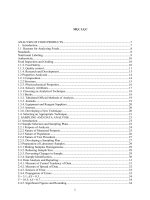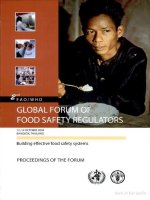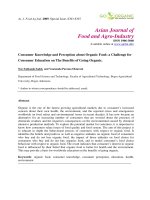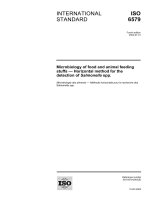P PATH OF FOOD
Bạn đang xem bản rút gọn của tài liệu. Xem và tải ngay bản đầy đủ của tài liệu tại đây (34.08 KB, 2 trang )
PATH OF FOOD
Food → oral cavity (saliva secreted) → Teeth (break food) →
pharnyx → esophagus → stomach (enzymes, digest protein) →
small intestine (enzymes, digest most of the food, absorb
nutrients) → large intestine (defecation).
The path of food is one of the most important processes in our
body since it helps us to digest food, absorb the nutrients and
defecate the waste.
The digestion of food starts when food is chewed with saliva
secreted in the oral cavity.
The teeth would then break food into smaller pieces which help
our body to swallow food easily.
To swallow, the tongue pushes the food to the back of the mouth
and into the pharnyx, which is commonly known as a throat.
After entering the pharnyx, the food would move itself to the
esophagus, going directly to the stomach where the digestion of
protein takes place.
In here, the stomach, food would be mixed with the enzymes
which are the molecules that help chemical reactions to go faster.
After being liquefied with enzymes, the food leaves the stomach
and goes to the small intestine.
When food is stored in the small intestine, digestive enzymes
would be released to cut food into smaller pieces, which leads to
the easier process of nutrient absorption.
Once the nutrients have been absorbed, the food waste would
finally be pushed into the large intestine where defecation
happens.
In conclusion, because of the above important steps that a path of
food has, we should eat well and maintain a healthy lifestyle.
- Phải đủ ý.
- Có câu mở đầu, câu kết thúc.
- Nối các câu lại với nhau để đoạn văn mạch lạc hơn (bôi đậm
in nghiêng).
- Các từ vựng chuyên ngành cần phải có (cam).
- Ngữ pháp:
+ Xen kẽ câu đơn giản - câu phức tạp (xanh). Dạng câu
phức tạp “đơn giản nhất” là cứ viết ra xong thêm
which/when/where (mệnh đề quan hệ) vơ là xong. Thí
dụ nha: Sinh học tế bào is a difficult subject, which has
so many things to learn and so many students to resit
(thi lại) for it again. The teachers are quite boring, who
are just always re-reading what they have written in
their powerpoints. But no matter how tedious this
subject seems to be, all I need is just a 4.0, which is the
requirement for “Pass”. And luckily, I passed!
+ Chú ý các lỗi ngữ pháp dễ sai như: a/an/the (food hoặc
the food đều đc, the stomach/large intestine … mới
đúng) ; số ít số nhiều nhớ thêm s (one of the + số nhiều
(s), enzymes, steps, …) ; danh từ số ít khi chia ở thì hiện
tại phải thêm s (the tongue pushes, the food leaves)
nhưng sau modal verbs (can/may/might/would) thì
khơng cần thêm s (the teeth would then break, the food
would move itself).
+ Dùng xen kẽ active - passive voice (digestive enzymes
would be released, the food waste would be pushed…)
+ Chia ở thì hiện tại (bao gồm hiện tại đơn - hiện tại tiếp
diễn và hiện tại hoàn thành). Chú ý: Once + hiện tại
hoàn thành (vế trước), hiện tại đơn bình thường (vế
sau).
- Những cách khác nhau để diễn đạt “diễn ra ở” (in đỏ): take
place = occur = happen.









